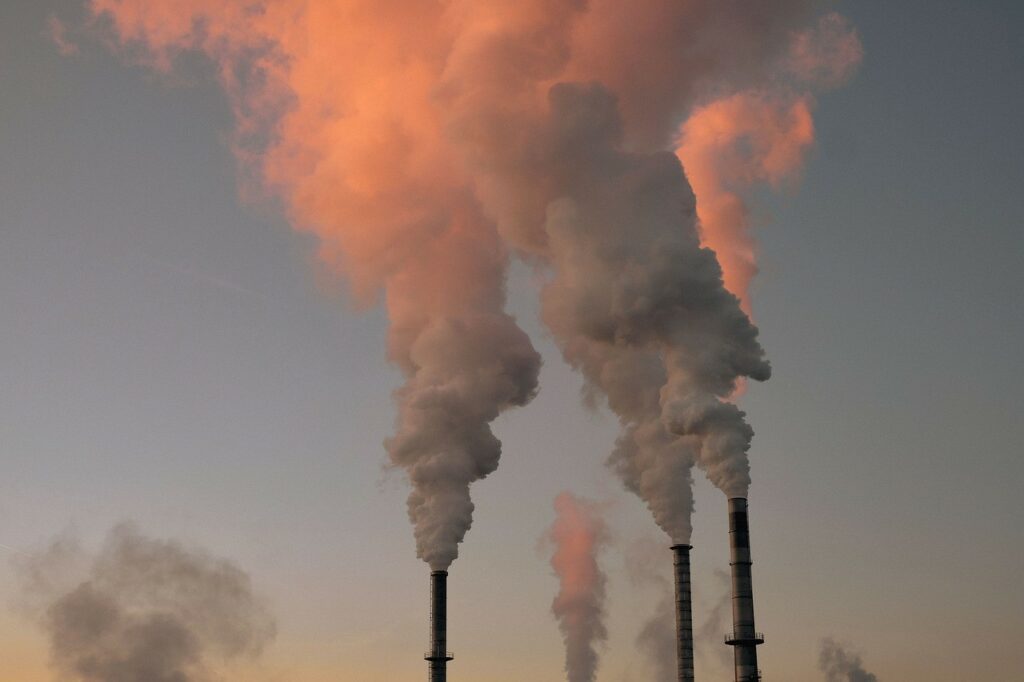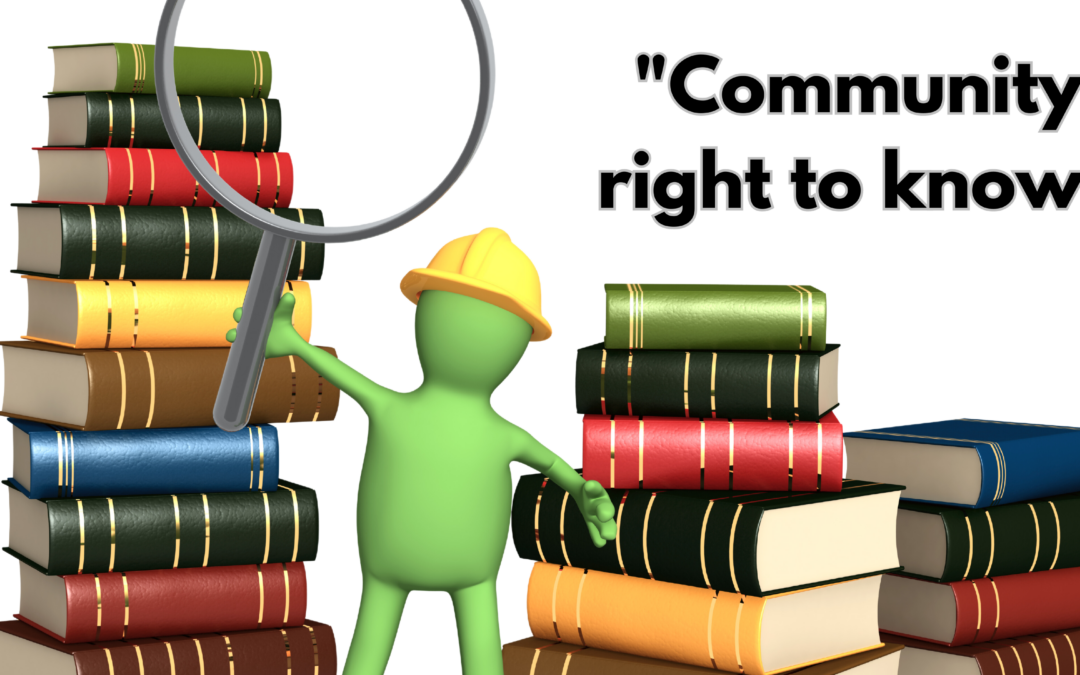“Community Right to Know” is the belief that the Community should be informed and involved in the decision-making of their area, especially decisions with the potential to affect their lives and environment. This includes access to information surrounding developments from the planning up to the operational phase, information about harmful substances that surround their daily lives, and the possible or potential impacts they have. Australian residents should have the ability to know about, participate in and challenge environmental developments, as outlined in the United Nations Rio declaration, see Figure 1. “Community Right to Know” encapsulates the belief that access to a healthy, safe environment is a human right (World Resources Institute, 2023). “Community Right to Know” has been implemented internationally, with aspects of the fundamental American Emergency Planning and Community Right-to-Know Act 1986 (EPCRA) being adopted globally (Gunningham, 2018).

Source: Wilderness Society
Prior to the “Community Right to Know” principles being established, Governments controlled environmental decision-making, which could lead to an alignment with private and business interests. As a result, private parties and businesses often benefit at the cost of the environment and community (Wilderness Society, 2023). The community was unrepresented in decisions that directly affected their health and environment. At the foundation of the movement is the belief that every human being has the right to a healthy, safe environment and that they have a right to be involved in decisions that impact their health and the environment (World Resources Institute, 2023). An example of the importance of community involvement is community-led rainwater testing near Orange, New South Wales, which revealed unsafe levels of heavy metals in water from rainwater tanks being used for household water supplies. This led the NSW Health Department to investigate the sources, determine the health risks and to stop the contamination. The department also notifies those affected (Wahlquist, 2023).
It is now well understood that the community’s involvement in decision-making can be improved through laws, policies and regulations which empower the public. Public participation in environmental decision-making results in developments that serve the broader community and environment. Increasing the accountability and transparency reduces emission and produce better environmental outcomes. It can also motivate industry and businesses will prioritise safe alternatives and more efficient approaches to gain public recognition (Gunningham, 2018).
What Rights Is Every Australian Entitled to?
“Community Right to Know” aligns with the belief that a healthy environment is a human right (Environmental Defenders Office, 2020). Human rights are established to protect individuals’ quality of life, encompassing social, economic, civil and political rights. Social / Economic Rights are things that should be accessible to all, such as housing, healthcare and sanitation; however, access to a healthy and safe environment is not recognised under Australia’s law as a human right, even though it is a significant indicator/contributor to human health and quality of life. Civil / Political Rights are actions we should be free to do without government interference, such as expressing opinions and protesting, yet, the public is progressively being subdued on environmental decisions and development (Parliamentary Education Office, 2022). Human rights depend upon the environment’s health; as a result, the environment’s health should be prioritised through “Community Right to Know” principles (United Nations, n.d.).
The community represents individuals with varying values, ages and health. We are all entitled to Human Rights (MacQueen, 2001). Operations can expose the community to noise, odours, emissions, and dust, which may cause harm to individuals (Environmental Justice Australia, 2022). Community uproar can occur when Communities are not consulted prior to a development, or there are impacts that cross-property bounds (Chai, 2016). Mutual understanding between the public and business is required to avoid conflict and harm to the public and the environment (EPA Victoria, 2004). Since 1992, the United Nations has recognised the role of public participation in environmental decision-making. For some businesses, Community consultation or engagement is an afterthought. Engagement and information sharing should occur through all phases of a new activity, whether it is the rollout of a new chemical, new road, new housing estate or mine. Community consultation can occur through reference groups, public meetings, social media, discussions and surveys (Peng, 2020). Technical information should be presented in a way that’s easy to understand by the broad community. Governments and businesses can remove mistrust and misinformation by engaging early and with the right information (EPA Victoria, 2004).
What processes exist in Australia that fall under Community Right to Know?
“Community Right to Know” recognises that people should be aware of decisions that directly affect them or potentially impact their way of life (United Nations, 2010). This can be accomplished through access to information regarding things that affect public health, such as unseen hazards and environmental harm (SWA, n.d.). Within Australia, there is environmental information available through Government departments such as the Department of Climate Change, Energy, the Environment and Water (DCCEEW), the Department of Water and Environmental Regulation (DWER) and the National Pollution Inventory (NPI). These sources provide information on land, water and air pollution. This information is accessible to all, enabling the public to be aware and informed of the potential harm. The DCCEEW and DWER provide information regarding hazardous waste, air quality, scheduled waste, waste and recycling and chemicals through their websites, https://www.wa.gov.au/organisation/department-of-water-and-environmental-regulation and https://www.dcceew.gov.au/ (DCCEEW, 2023). Also, the WA Environmental Protection Agency (WA EPA) release via their website (https://consultation.epa.wa.gov.au) information on Projects and Proposal that have been referred to them, or they are assessing. This allows the public to project raise concerns and to provide feedback on the developments, which aligns with “Community Right to Know” values.
Below are three examples of “Community Right to Know” initiatives occurring in Australia.

Source: Pixabay
NPI
The National Pollution Inventory (NPI) found at https://www.dcceew.gov.au/environment/protection/npi is a fundamental part of the integration of the “Community Right to Know” in Australia (Gunningham, 2018). The NPI is a publicly available database used to quantify emissions of pollutants into air, water and land. It fulfils the “Community Right to Know” belief that information surrounding harmful substances should be accessible to all (EJA, 2022). This transparency is beneficial as it can drive improved policy-making, leading to reduced emissions and improved environmental outcomes through awareness of pollution levels. By having emission information publicly available, pressure can be exerted by the public on businesses to reduce their emissions. This can also result in a rivalry between companies to lowest their emissions gaining public favour/praise. Also, having this information available to all will increase uniformity within the industry. One company may have higher emissions than another without realising that, with public accessibility, the industry can reflect and compare itself to its peers. The NPI arose from community demand for information on local toxic substances. The use of the NPI includes increased awareness, understanding, and transparency of information (DCCEEW, 2022b). Industry release of toxic substances is tracked through self-reports, and the government estimates all other sources. The NPI is a core part of Australia’s “Community Right to Know” implementation with solid fundamentals.
However, there is room for improvement, such as better policies and more accurate information provided, as currently, all emission information is self-reports by the industry or estimates by the Government (DAWE, 2021). Further improvement and development of the NPI will result in improved environmental outcomes and business/industry efficiency (Gunningham, 2018).
Air quality monitoring point in WA
Tracking air pollution is important. When pollution outside safe ranges, it can be harmful to people’s health and the environment. The DWER is responsible for air quality monitoring across WA in accordance with the National Environment Protection (Ambient Air Quality) Measure (1998) (NEPM). There is a network of air quality monitoring sites across Perth, in Kalgoorlie, Albany, used to track air pollution. These sites provide an hourly update of air quality and are accessible to all via https://www.der.wa.gov.au/your-environment/air/air-quality-index. The Air Quality Index tracks nitrogen dioxide, ozone, sulphur dioxide, and particles hourly and carbon monoxide every eight hours as per the monitoring plan prepared in accordance with the NEPM (DWER, 2023b). The NEPM sets standards for six air pollutants, carbon monoxide, ozone, nitrogen dioxide, sulphur dioxide, lead and PM10, which is a measure of tiny particles. The data collected is used for different purposes, including “Community Right to Know” obligations. Significant contributors to air pollution in WA are motor vehicles, prescribed burns and industrial activities (DWER, 2023a). The air quality index categorises air quality by a traffic light system, as seen in Table 1 (DWER, 2023b).

Pollution Watch
DWER also has a round-the-clock service where anyone can report pollution, illegal dumping or other environmental matters. This allows the Community to express concerns surrounding activities that are harmful to the environment. Reporting harmful activity allows the DWER to investigate and mitigate environmental harm. Matters that are reportable to the Pollution Watch include odour, noise, dust, unlawful clearing of native vegetation, illegal dumping, littering, emissions or discharges into the environment, smoke/smoky vehicles, impacts to plants and animals and contaminated sites (DWER, 2023c). This service deters large-scale environmental harm and provides accountability for harmful actions. The Pollution watch encourages community participation and involvement in the management of potentially harmful activities and is another activity that aligns with the “Community Right to Know” principles in WA.

Source: Pixabay
International examples – The American Emergency Planning and Community Right to Know Act 1986
The US Emergency Planning and Community Right-to-Know Act (EPCRA) has provided a framework for the “Community Right to Know” movement internationally. The creation of the EPCRA was in response to a 1984 incident in India, where the accidental release of a chemical, methylisocyanate, killed and severely injured >2000 people. The EPCRA looked to minimise environmental and human hazards by regulating the safe storage and handling of toxic chemicals. It included emergency plans if hazardous chemicals were released and “Community Right-to-Know” principles which increased public knowledge and provided access to useful information (US EPA, 2023). These fundamentals provided a base for many other international acts that adopted “Community Right to Know” principles.
The EPCRA established the Toxic Release Inventory (TRI), which was the bases for the Australia NPI. The TRI revealed in its first year that 22 billion pounds (~10 million tonnes) of harmful chemicals had been discharged into the environment, demonstrating the majority of toxic chemicals were not regulated by the government. The TRI enabled the public to 1. develop a table of toxic polluters and compare companies performance, 2. to identify local toxic hot spots, 3. provide evidence to justify the introduction of toxic use reduction legislation, 4. encourage the proactive reduction of emissions in companies, 5. increased company awareness of emission levels, and 6. centralised information. The implementation of the TRI resulted in many positive outcomes for the environment and community in the US. (Gunningham, 2018).
Benefits
“Community Right to Know” began with the US EPCR Act 1986; this provided the fundamental framework of the right to know, the right to participate, and the right to challenge. People should be informed and involved in environmental decision making especially when the activity involves harmful substances and is likely to impact the community. Positive environmental outcomes are achieved through public participation and Government/Industry transparency.
A healthy environment is a legal right in the majority of the World. However, Australia is yet to legislate this. Although the environment as a human right is not established in legislation in Australia, there are many things that align with “Community Right to Know” principles, such as our NPI and Air Quality Watch. Public participation in proposal/project assessments through the WA EPA assessment process aligns with the “Community Right to Know” right to challenge. Australia may benefit from a further increase of public participation and community authority in decision-making, stricter laws/policies regarding emissions and legislation surrounding the environment as a human right.
While legislation established tools and processes that facilitate the “Community Right to Know”, Businesses can also do their bit by engaging with their local communities or potentially impacted parties to keep them informed about their activities. Businesses can also set up processes to share monitoring results and the outcome of the management measures.
If your company would like to review your existing Community and Stakeholder Engagement process or would like assistance in setting one up, Integrate Sustainability can assist. Our team has extensive experience with establishing engagement and consultation processes and tools to share information with interested parties. If you would like to find out more, please call 08 9468 0338 or email us at enquiries@integratesustainability.com.au.
References
Chai, T. (2016). The Importance of Public Participation. Retrieved from https://ejsclinic.info.yorku.ca/2016/04/the-importance-of-public-participation/
DAWE. (2021). National Pollutant Inventory Review Report presented by the Department of Agriculture, Water and the Environment. Australian Government.
DCCEEW. (2022a). Implementation of the NPI NEPM presented by the Department of Climate Change, Energy, the Environment and Water. Retrieved from Australian Government: https://www.dcceew.gov.au/environment/protection/npi/about/implementation
DCCEEW. (2022b). About the NPI presented by the Department of Climate Change, Energy, the Environment and Water. Retrieved from Australian Government: https://www.dcceew.gov.au/environment/protection/npi/about
DCCEEW. (2023). Environment protection publications and resources presented by the Department of Climate Change, Energy, the Environment and Water. Retrieved from Australian Government: https://www.dcceew.gov.au/environment/protection/publications#hazardous
DEC. (2006). A Guide for Engaging Communities in Environmental Planning and Decision Making presented by the Department of Environmental Conservation NSW. Retrieved from https://www.environment.nsw.gov.au/resources/communities/2006288-Engaging-Communities.pdf
DEP. (2001). National Environment Protection Measure for Ambient Air Quality: Monitoring Plan for Western Australia presented by the Department of Environmental Protection.
DWER. (2023a). Air quality presented by the Department of Water and Environmental Regulation. Retrieved from Government of Western Australia: https://www.wa.gov.au/service/environment/environment-information-services/air-quality
DWER. (2023b). Air quality index presented by the Department of Water and Environmental Regulation. Retrieved from Government of Western Australia: https://www.der.wa.gov.au/your-environment/air/air-quality-index
DWER. (2023c). Pollution Watch presented by the Department of Water and Environmental Regulation. Retrieved from Government of Western Australia: https://www.wa.gov.au/service/environment/pollutant-prevention/pollution-watch
EDO. (2020). Legal analysis: The right to a healthy environment in Australia. Retrieved from Environmental Defenders Office: https://www.edo.org.au/2020/01/09/right-to-healthy-environment-in-australia/
EJA. (2022). National Pollutant Inventory (NPI) presented by the Environmental Justice Australia. Retrieved from https://envirojustice.org.au/our-focus/national-pollutants-inventory/
Environmental Defenders Office. (2020). Legal analysis: The right to a healthy environment in Australia. Retrieved from https://www.edo.org.au/2020/01/09/right-to-healthy-environment-in-australia/
Environmental Justice Australia. (2022). National Pollutant Inventory (NPI). Retrieved from https://envirojustice.org.au/our-focus/national-pollutants-inventory/
EPA Victoria. (2004). Industry and Community Consultation presented by the Environmental Protection Agency Victoria. EPA Information.
Gunningham, N. (2018). Legislating the right to know. Environmental and Planning Law Journal.
MacQueen, K. (2001). What Is Community? An Evidence-Based Definition for Participatory Public Health. Retrieved from National Library of Medicine: https://www.ncbi.nlm.nih.gov/pmc/articles/PMC1446907/
Parliamentary Education Office. (2022). Rights in Australia. Retrieved from https://peo.gov.au/understand-our-parliament/how-parliament-works/system-of-government/rights-in-australia/
Peng, Y. (2020). Public Participation in Environmental Decision-making. Retrieved from WeSolve BETTER TOGETHER: https://wesolve.app/public-participation-in-environmental-decision-making/
SWA. (n.d.). Access to information. Retrieved from Safe Work Australia: https://www.safeworkaustralia.gov.au/access-information
United Nations. (1999). Report of the United Nations Conference on Environment and Development. Retrieved from https://www.un.org/en/development/desa/population/migration/generalassembly/docs/globalcompact/A_CONF.151_26_Vol.I_Declaration.pdf
United Nations. (2010). Freedom of Information: The Right to Know. United Nations Educational, Scientific and Cultural Organization. Retrieved from https://uncaccoalition.org/resources/access-to-info/freedom-of-information-the-right-to-know-unesco.pdf
United Nations. (n.d.). About human rights and the environment. Retrieved from https://www.ohchr.org/en/special-procedures/sr-environment/about-human-rights-and-environment
US EPA. (2023). What is EPCRA? Retrieved from United States Environmental Protection Agency: https://www.epa.gov/epcra/what-epcra
Wahlquist, C. (2023). Community-led rainwater testing near Orange finds one in three tanks have unsafe lead levels. Retrieved from The Guardian: https://www.theguardian.com/australia-news/2023/mar/13/community-led-rainwater-testing-near-orange-finds-one-in-three-tanks-have-unsafe-lead-levels
Wilderness Society. (2023). Environmental community rights. Retrieved from https://www.wilderness.org.au/community-power/environmental-community-rights
World Resources Institute. (2023). Environmental Rights. Retrieved from https://www.wri.org/equitable-development/environmental-rights

